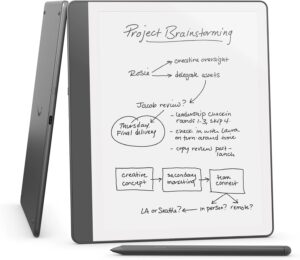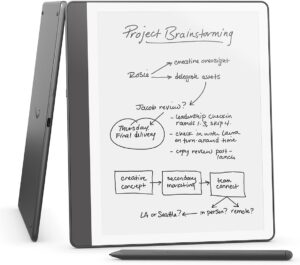Amazon Kindle Scribe (2024 Model) Review
Amazon’s Kindle Scribe combines a top-tier display with advanced note-taking features and AI-powered tools. In this Kindle Scribe review, I tested the design, writing experience and real-world value to determine whether it’s worth the price.
The Kindle Scribe is Amazon’s boldest take on an e-reader yet, merging its signature e-ink reading experience with handwriting and note-taking features. It’s well designed for readers who want more than just digital books, providing space for annotating, journaling and organizing ideas, all in one convenient place.
As one of the most advanced Kindles in Amazon’s range, the Scribe sits right at the top of the pile in terms of functionality and price. If you’re wondering whether it’s worth the splurge, read on for my in-depth testing results. Alternatively, if you’re not sure which Kindle model would suit you, take a look at our guide on the best Kindle to purchase.
What Is a Kindle Scribe & Who Is It For?
The Kindle Scribe is Amazon’s large-screen e-ink reader that you can also write on. It’s built for readers who want a distraction-free device for reading, taking notes and annotating PDFs, books and files. It’s a great choice for students, researchers and professionals who prefer solid battery life and a paper-like feel over tablet apps or color screens.
- Release date: 2024
- Developer: Amazon
- Dimensions: 196 x 230 x 5.7 mm
- Storage: Up to 64GB
- Display: 10.2-inch, 300 PPI Paperwhite e-ink
- Operating system: Kindle OS
- Notable features: Active canvas, premium pen, AI notebook tools, Bluetooth for Audible
- Pricing: From $399.99 for 16GB with premium pen
The Cloudwards Expert Opinion
Amazon Kindle Scribe (2024) Pros & Cons
Pricing: How Much Is a Kindle Scribe (2024)?
The Kindle Scribe is one of Amazon’s most expensive e-readers — well above the price of the standard Kindle and Paperwhite editions. For comparison, the entry-level Kindle costs around $110, while the Paperwhite starts at $160. The Scribe’s $400 base price is a significant jump, but that’s largely due to it being both an e-reader and a digital notebook.
The Scribe is about the same price point as other hybrid devices, such as the ReMarkable 2, but you get more storage space, an adjustable backlight and excellent note-taking capabilities.
| Model: | Price |
|---|---|
| Kindle Scribe 16GB | $109.99 |
| Kindle Scribe 32GB | $419.99 |
| Kindle Scribe 64GB | $449.99 |
While it’s not a casual purchase, the Scribe offers clear value if you want all-in-one reading and note-taking. If you’re upgrading from a Paperwhite or an Oasis, think of it more as a productivity device than simply a fancier e-reader. Plus, all new Scribes come with a free trial of Kindle Unlimited, and you can download plenty of free e-books.
Kindle Scribe (2024) Display
The Kindle Scribe’s 10.2-inch display is one of the best e-ink panels Amazon has created. It has a resolution of 300 PPI (pixels per inch), so text looks sharp and consistent across books, documents and handwritten notes. The larger screen size makes it easier to read PDFs or academic papers, all while maintaining the same crisp contrast I expect from a Kindle.
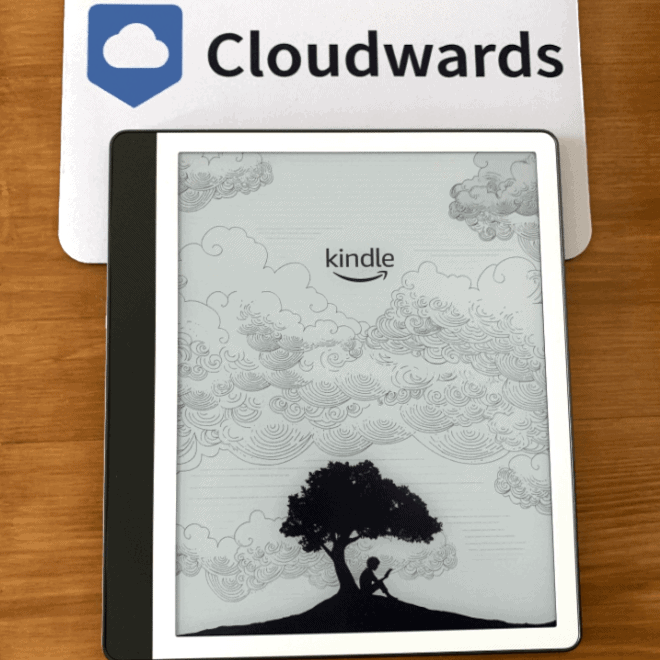
As far as colors go, well, there aren’t any. The Scribe’s screen is in greyscale, but the brightness and warmth controls help prevent long reading sessions from becoming taxing on the eyes. The front light setting is adjustable, so you can switch from cool daylight tones to a warmer, amber hue for nighttime reading.
Compared to the Paperwhite, the Scribe is brighter at maximum settings, and its anti-glare surface minimizes reflections (perfect for outdoor reading). However, with the much larger panel, I did notice that the refresh rate feels a touch slower when flipping pages or navigating menus.
Actual Paper Feel
I initially thought the “paper feel” of the Kindle Scribe was a bit of a gimmick, but I was gladly mistaken; it really does feel like writing on real paper. The matte surface offers a subtle resistance that feels natural when writing, and the feedback is tactile without being scratchy.
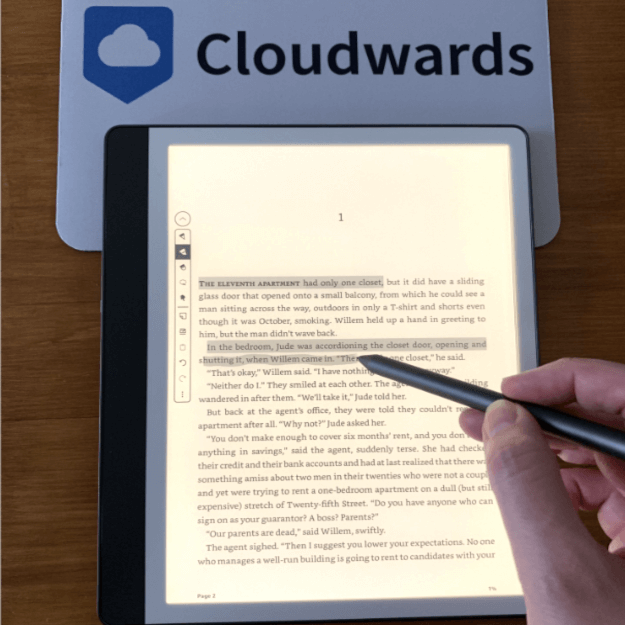
Compared to the Kindle Paperwhite, the difference is significant. Granted, the Paperwhite is designed for touch gestures and reading, while the Scribe is designed to react to a stylus. For accuracy, though, the difference is night and day. The Scribe and its premium pen are much more intuitive and precise than typing or tapping on a standard e-ink screen.
If your main goal is to replace a paper notebook, the Scribe comes very close. It’s not perfect (you’ll still hear a faint tapping from the stylus, after all), but writing with it is responsive, accurate and satisfying enough to make traditional paper feel almost unnecessary.
Kindle Scribe (2024) Software
The Kindle Scribe runs Amazon’s proprietary operating system, Kindle OS. This custom Linux-based firmware has been enhanced for stylus input and note handling. It’s not an open platform, so you can’t install third-party apps; instead, it supports native Kindle, document and note-taking apps.
The Scribe’s key software capabilities include the following:
- Active canvas: Scribble on any page in a Kindle e-book, and the OS will create a dynamic overlay or margin, so your notes stay in context.
- Notebook mode: Create standalone notebooks for meetings, to-do lists or journaling.
- PDF/document import: Add your own files to your Scribe for annotation.
- Handwriting conversion and refinement: Convert your handwritten notes into typed text, with a “refined writing” option to improve the legibility of your handwriting.
- AI tools: Generate summaries of your notes, adjust the tone and length, or refine sections automatically.
- Sync and access via cloud/Kindle apps: Notebooks and highlights sync via Amazon’s cloud so you can read notes via the Kindle mobile apps. Some active canvas notes may not translate fully, though.
- Reading features: Adjustable fonts, dictionaries, lookup tools, highlighting (and highlight exports), Sync (formerly Whispersync) and night mode are all available on the Scribe.
There are a few limitations. For example, the Scribe lacks waterproofing and has slightly less snappy transitions than smaller Kindles. However, despite not being a full tablet OS, it’s coherent and smooth for reading and writing, and tightly integrated into Amazon’s full ecosystem.
Active Canvas
The active canvas feature sets the Scribe apart from earlier Kindles, letting you write directly within books and documents. You can add handwritten notes, highlights or sketches to virtual sticky notes or margins. The notes are linked to the location in your e-book or file so they’re easy to find later.

While editing is limited to the Scribe itself, you’ll find that notes now sync to the Kindle app, so you can view them on your phone or desktop. Pen input is smooth and more responsive, with very little visible lag — much like writing on a sheet of paper.
Compared to the simple tools of previous Kindles, active canvas feels transformative. It turned reading into an interactive experience for me, and it could be valuable for students, editors or professionals who annotate their work.
Note-Taking & Handwriting
The note-taking capability might be my favorite Scribe feature. The pen, with its soft tip and pressure response, lets you sketch, doodle or write with crisp accuracy. Writing feels smooth, with minimal latency, even when writing for longer periods.
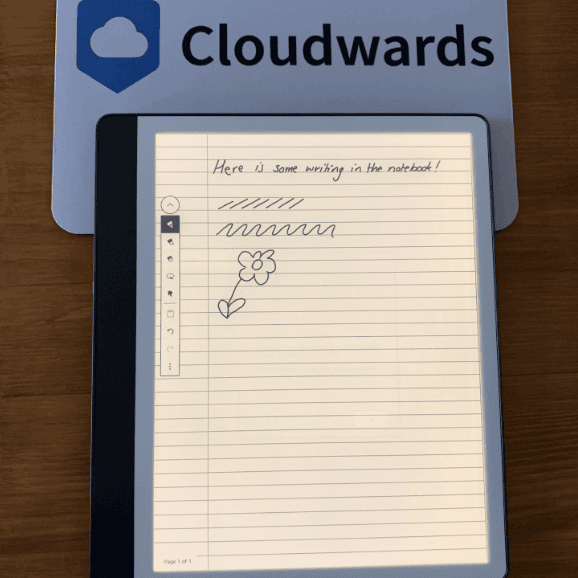
You can create notebooks within folders and build each one from a template (such as grid or lined, checklist or planner) to suit your work style. Handwriting conversion lets you change your notes into typed text, but the conversion accuracy isn’t 100% yet (it’s pretty close, though).
The organizational features are solid. You can group notebooks, search by title and sync your content to the cloud. You can also freely add and move pages within notebooks, but you can’t move pages between different notebooks. This function would be genuinely useful, but it’s not a deal-breaker for me.
AI Features
It was inevitable that artificial intelligence would make its way to the Kindle, and Amazon has handled it well. The Scribe’s generative AI tools complement its note-taking capabilities — in particular, the notebook summarization and handwriting refinement features.
Notebook summarization lets you select up to 15 pages from a notebook and create a bulleted summary with adjustable length and tone options. This is especially handy for students with lecture notes. Handwriting refinement converts your notes into a script-style font so they’re easier to read and share.
You’ll need an internet connection to use the AI tools, as Amazon’s servers handle them. They’re not particularly game-changing, but they work well and streamline reviewing and sharing notes.
Amazon Kindle Scribe (2024) Hardware
The Scribe’s hardware is sturdy and well balanced despite its size. It’s the biggest and heaviest Kindle but is lighter than most tablets, so it’s comfortable for extended use. I was impressed by the device’s high-quality feel, with a matte finish that hides fingerprints and a solid grip area for a comfortable hold while reading.
You’ll find a USB-C port that supports fast charging, bringing the battery from empty to full in just over two hours. Amazon claims it’ll last up to 12 weeks on a single charge with regular reading and occasional note-taking, which aligned pretty closely with my experience.
The only feature the Scribe lacks is waterproofing. However, given its size, it’s not all that practical for reading in the bath or at the beach.
Kindle Scribe Upgraded Premium Pen
The Scribe’s premium pen has undergone some upgrades since its initial release. It’s battery-free, using electromagnetic resonance (EMR) tech so it never needs to be charged or paired. Plus, the pen is lightweight but solid, with a soft matte finish that prevents slipping even during a long writing session.
There’s a customizable shortcut button and a soft-tip eraser at the top, both of which are highly responsive. The eraser feels smooth and more natural, with little delay between motion and response. I like that you can remap the shortcut button to switch between pen types (such as toggling from pencil to highlighter) directly in the settings menu.
Compared to earlier versions, the pen tip is much more durable and less prone to wear. The Scribe also comes with several replacement tips for when the pen tip eventually wears out, which could be anywhere from three weeks with heavy use to three months for light note-taking.
Kindle Scribe (2024) Dimensions
The 2024 Scribe is about the same size and weight as the previous model but is significantly larger and heavier than other Kindles. However, compared to other tablets it’s lean and light.
| Metric: | Kindle Scribe (2024) |
|---|---|
| Height x width x depth | 196 x 230 x 5.7 mm |
| Weight | 433 grams |
How Does Kindle Scribe Compare to Other Kindles?
It’s clear that the Scribe is a significant step up from other Kindle models in terms of capabilities and price. It bridges the gap between e-readers and digital notebooks, whereas other Kindles are focused solely on reading. The Scribe isn’t intended to replace the smaller Kindles; it’s really in a category all its own.
| Model: | Display | Storage | Battery Life | Starting Price | Best For |
|---|---|---|---|---|---|
| Kindle | 6 inches | 16GB | Up to 6 weeks | $109.99 | Basic reading |
| Kindle Oasis | 7 inches | 8GB, 32GB | Up to 6 weeks | $115.90 | Premium, ergonomic reading |
| Kindle Paperwhite | 7 inches | 16GB | Up to 12 weeks | $159.99 | Avid readers |
| Kindle Scribe | 10.2 inches | 16GB, 32GB, 64GB | Up to 12 weeks | $399.99 | Reading & note-taking |
Final Thoughts: Is Kindle Scribe Worth It?
In short, yes, the Kindle Scribe is worth it. I find the Scribe to be the most versatile Kindle device Amazon has made, combining the comfort of traditional Kindle e-readers with a writing experience that feels almost like the real deal. It’s not the Kindle for everyone, but it’s a great option if you want a focused productivity tool in the Amazon ecosystem.
What do you think of the Scribe? Do you prefer a simple Kindle for reading, or does the option to write in your e-books make this the ultimate upgrade? Let us know in the comments, and thank you for reading.
FAQ: New Kindle Scribe Review
The Kindle Scribe lets you read e-books and handwrite notes directly on the screen using the included stylus. It’s an e-reader and notebook combined in a single device
It depends. The ReMarkable 2 feels slightly more natural to write on, but the Scribe is better for reading, note-taking and syncing with Amazon’s ecosystem.
Yes, the matte screen and responsive pen create a realistic paper-like feel, with just enough resistance to make it feel like you’re writing on real paper.
Yes, you can create unlimited notebooks with a variety of templates and sync them to the cloud for easy access.

